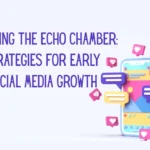While the digital landscape of 2025 is certainly more competitive than it was in the past, there’s also greater opportunity than ever before. Digital infrastructure has become much more robust, and beginners can now use tools that were once off-limits to anyone other than expert developers to produce professional results.
There’s no shortage of ways to succeed, and no matter what sort of business you seek to grow, you have a great shot at carving out a little piece of the internet for yourself.
That said, just because the process is easier than it was doesn’t make it a breeze. You’ll still have to put in a lot of effort, and with so many potential directions, it can be difficult to know where to begin and what to focus on.
To help get you started, here are 7 key considerations for growing your business’s online presence in today’s world.
-
Nailing Down Your Goals
Before you think about building a website and creating a strong online infrastructure for your business, you’ll need to define your goals concretely.
Consider your target audience, what they really need, and where you fit in. Conduct research into what your biggest competitors are doing, and double down on how you do things differently (and better) than them. Spend plenty of time defining these elements, as they’ll be your guide for every decision you make going forward.
-
Utilizing AI Tools for SEO
SEO (Search Engine Optimization will comprise a significant part of your overall strategy, as it largely governs how people find, and then subsequently click, on your website or social media accounts.
SEO has changed a lot over the last few years, and today, AI-driven sentiment analysis is where it’s at. Rather than simply spitting out some useful keywords, today’s tools analyse your customers’ values and intentions and how they relate to the keywords they’re searching for. They also drill into how AI large language models (LLMs) like ChatGPT and Gemini showcase your brand via prompt results.
-
Strengthening Your Visual Brand Identity
Virtually everyone today has a high-resolution smartphone, and given that these devices will be how the majority of your customers interact with your content, you’ll want to make your visual assets as visually appealing as possible.
You should first use your core research from point one to decide what sort of fonts and color scheme you should use, and from there, you can approach a graphic designer to come up with a logo that fits.
On the internet, visual brand identity goes further than just those elements: it’s also key that your website’s user interface (UI) is up to scratch. Animations when clicking between tabs and pages, as well as how content transitions from one frame to the next when scrolling up or down, can make a big difference. Most website builders have intuitive features that enable users to make the necessary modifications, but you could also get help from a professional web designer.
-
Using Data Analytics to Better Understand Your Progress
It used to be the case that deep data analysis was only on the cards for those with access to thousands of dollars’ worth of research, but those days are over.
Today, you can gain the key insights you need about consumer sentiment and growth trends by utilizing easy-to-use subscription services that help you analyse your data in minutes. Even the Google Suite now has an impressive set of tools that you can use for free.
Understanding conversion rates, content engagement, funnel performance, and so on, is an essential element for establishing growth over the long term, so prioritise data analysis early.
-
Considering Paid Media
Paid media can be an invaluable asset if you build the right partnerships. The term refers to any marketing channel where you pay for ad placement, and it can encompass search ads, video ads, social media ads, retargeting, and influencer partnerships (the latter of which will only become more valuable as time goes on).
Quality is more important than quantity: a select few channels will always work better than simply paying for hundreds of untargeted ads, so think carefully about where you want to make your placements (your overall brand strategy should guide you well here).
-
Creating High Quality Content
It may seem like it goes without saying that any content you produce should be of high quality, but you’d be surprised at how many businesses don’t prioritize this step enough.
Content is king in 2025, and you want to make sure that everything you put out builds authority and trust in your brand. People can spot shodily put-together videos a mile off, and while volume is important when it comes to blog and social media posts, it should never come at the expense of not respecting your audience.
Each piece of content you make should seek to solve a problem for your customer base and showcase why you’re the best business to help them.
-
Bringing in the Experts for Specialized Help
It’s okay that you don’t have the time to learn everything. There’s a tremendous amount that goes into building a water-tight digital strategy, and when you’ve already got a business to grow, it can be a tall order to assimilate the information you need.
A dedicated enterprise SEO agency can help you here. They’ll use their experience of the continually changing market to establish a bespoke strategy that works for you, attacking your biggest challenges from all sides. Not only this, but any agency worth its salt will provide you with clear, ongoing data analysis to ensure things are measurably moving in the right direction.
Wrapping Up
You should now have a better idea of the core elements you need to prioritize as you endevour to grow your business on the digital side. It’ll take a fair amount of effort to get things off the ground, but as you can see, there are plenty of tools, services, and strategies you can use to help you on your journey. Good luck!











